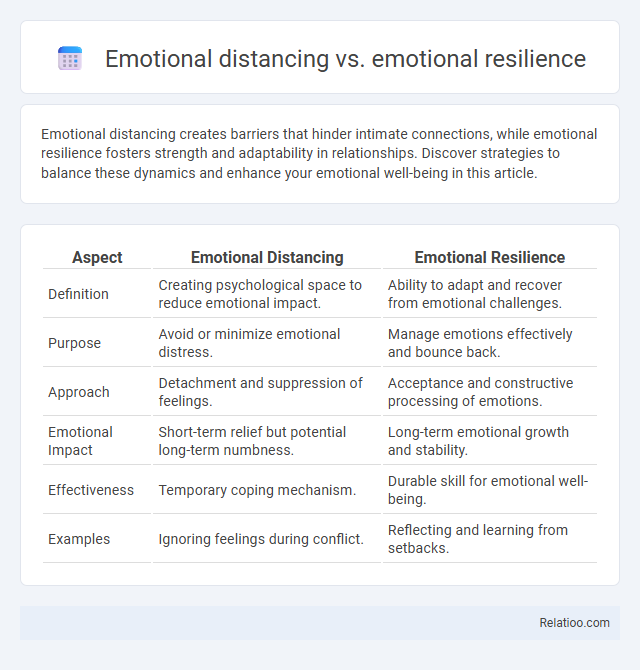Emotional distancing creates barriers that hinder intimate connections, while emotional resilience fosters strength and adaptability in relationships. Discover strategies to balance these dynamics and enhance your emotional well-being in this article.
Table of Comparison
| Aspect | Emotional Distancing | Emotional Resilience |
|---|---|---|
| Definition | Creating psychological space to reduce emotional impact. | Ability to adapt and recover from emotional challenges. |
| Purpose | Avoid or minimize emotional distress. | Manage emotions effectively and bounce back. |
| Approach | Detachment and suppression of feelings. | Acceptance and constructive processing of emotions. |
| Emotional Impact | Short-term relief but potential long-term numbness. | Long-term emotional growth and stability. |
| Effectiveness | Temporary coping mechanism. | Durable skill for emotional well-being. |
| Examples | Ignoring feelings during conflict. | Reflecting and learning from setbacks. |
Understanding Emotional Distancing
Emotional distancing involves creating a mental barrier to protect oneself from intense feelings, often leading to detachment or numbness. Emotional resilience refers to the capacity to adapt to and recover from emotional challenges without losing balance. Understanding emotional distancing requires recognizing it as a coping mechanism that can hinder genuine emotional connections if overused, contrasting with emotional resilience which promotes healthy emotional processing and growth.
Defining Emotional Resilience
Emotional resilience refers to the ability to adapt to stress, adversity, or trauma by maintaining psychological well-being and effectively managing emotional challenges. Unlike emotional distancing, which involves numbing or avoiding feelings to protect oneself, emotional resilience fosters healthy processing and recovery from difficult emotions. Developing emotional resilience enhances coping strategies, supports mental health, and promotes long-term emotional stability.
Key Differences Between Distancing and Resilience
Emotional distancing involves creating a psychological barrier to avoid emotional involvement, often leading to detachment and suppressed feelings, while emotional resilience refers to the ability to adapt and recover from emotional adversity through healthy coping mechanisms. Key differences include that distancing reduces emotional impact by avoidance, potentially causing isolation, whereas resilience enhances emotional strength by processing and managing emotions effectively. Resilience fosters growth and emotional regulation, whereas distancing primarily serves as a defense mechanism that may hinder emotional well-being.
Signs of Emotional Distancing
Signs of emotional distancing include withdrawal from meaningful conversations, reduced empathy, and a reluctance to share personal feelings or experiences. Your behavior may show increased irritability or avoidance of emotional situations, leading to a growing gap in relationships. Recognizing these symptoms early helps differentiate emotional distancing from emotional resilience, which involves adapting and maintaining connection despite stress.
Characteristics of Emotional Resilience
Emotional resilience is characterized by your ability to adapt to stress, recover quickly from setbacks, and maintain a positive outlook despite challenges. Unlike emotional distancing, which involves detaching from feelings to avoid pain, emotional resilience promotes emotional awareness and constructive coping strategies. This strength enables you to face adversity with flexibility and emotional balance, fostering long-term mental well-being.
Causes of Emotional Distancing
Emotional distancing often stems from past trauma, fear of vulnerability, or unresolved conflicts, which create barriers to genuine connection and trust. Your ability to develop emotional resilience depends on recognizing these causes and actively cultivating coping strategies, such as mindfulness and self-reflection, to manage emotional responses effectively. Unlike emotional distancing, emotional resilience enables you to maintain healthy relationships and navigate stress without shutting down or withdrawing emotionally.
Building Emotional Resilience
Building emotional resilience involves developing the ability to adapt and recover quickly from stress, adversity, or trauma by fostering positive coping mechanisms and maintaining emotional balance. Emotional distancing, often characterized by detachment or avoidance of feelings, can hinder resilience by preventing genuine emotional processing and connection. Strengthening emotional resilience requires mindful awareness, emotional regulation, and supportive relationships to navigate challenges effectively without resorting to emotional numbing or suppression.
Effects on Mental Health
Emotional distancing can lead to increased feelings of isolation and anxiety, negatively impacting mental health by reducing emotional support and connection. Emotional resilience enhances mental well-being by enabling individuals to adapt to stress and recover from adversity more effectively. Unlike emotional distancing, emotional resilience fosters healthier coping mechanisms and promotes psychological stability during challenging times.
Emotional Distancing in Relationships
Emotional distancing in relationships involves creating psychological space to protect oneself from perceived emotional harm, often leading to reduced intimacy and communication breakdowns. Unlike emotional resilience, which enables individuals to adapt and recover from emotional challenges, emotional distancing can hinder relationship growth by fostering detachment and misunderstandings. Understanding the balance between maintaining healthy boundaries and avoiding emotional withdrawal is crucial for sustaining strong, supportive connections.
Strategies to Transition from Distancing to Resilience
Shifting from emotional distancing to emotional resilience involves adopting strategies such as mindful self-awareness to recognize and validate feelings without avoidance. Developing adaptive coping mechanisms like cognitive reframing and seeking social support enhances emotional processing and fortitude. Consistent practice of stress-reduction techniques, including meditation and journaling, fosters integration of emotions, facilitating a healthier response to adversity.

Infographic: Emotional distancing vs Emotional resilience
 relatioo.com
relatioo.com